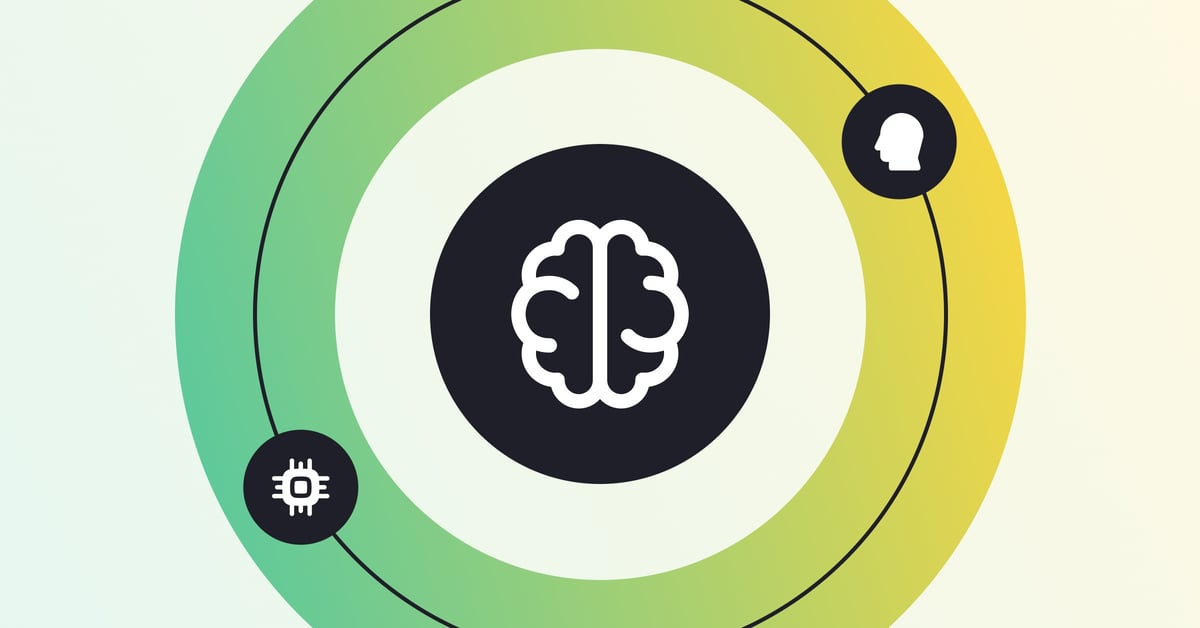What is AI?
Artificial intelligence (AI) is frequently explained as “machines mimicking the human brain.” Which sounds impressive, because, well, the human brain is impressive: It makes us empathetic, curious, and creative. And most importantly, our brains help us learn from past experience.
But machines bring something to the table humans never could: absolute efficiency. They’re pros at processing large amounts of data, which is why they’re better at math than we are and beat us at chess.
Artificial intelligence combines the best of both worlds: efficiency and the ability to learn from experience. And that powerful combination has been transforming the way we work, impacting industries from healthcare to customer service.
But while it’s true that AI helps machines enhance their skills with human-like cognitive abilities, the endgame isn't to replace humans or their labor: it's to complement them. In most cases, machines are employed to assist humans by taking over mundane tasks, leaving those jobs that require empathy or creativity to us.
What is AI in customer service?
AI in customer service usually takes the form of virtual agents who work alongside human agents to solve problems with the help of an AI model.
Working in customer service can be challenging: Agents need to work efficiently and accurately while providing the best experience possible whenever they interact with their customers. The tighter the resources, the harder it becomes to maintain that balance.
In recent years, automation has helped ease the burden on support agents. First-generation chatbots, for example, are able to provide instant answers to simple, FAQ-type questions. But they struggle with any requests that aren’t based on an often quite limited amount of keywords they’ve been programmed to answer. Here’s where AI comes in – conversational AI, to be exact.
What are examples of conversational AI in customer service?
Unlike older automation software, the algorithms behind conversational AI aren’t rules-based. Instead, they rely on neural networks -- structures resembling human brain cells -- which allow conversational AI to learn and adapt over time.
What does that mean for customer service? Simply put, AI-powered automation software can understand your customers better.
For example, the AI model we use at Ultimate is designed to classify customer intents. It's also receptive to training.
After it is fed industry-specific benchmark data, as well as your very own past support requests, our conversational AI model understands all the different ways in which your customers ask the same question.
Identify your most common requests based on your past support conversations with our free CS Automation Explorer tool.
It’ll know that “dark blue trousers” means the same thing as “indigo pants,” and that asking “Has my parcel left the shop yet” requires the same answer as “Where’s my order?”.
“Our virtual agents are intent classifiers. They model the intents people have.”
- Jaakko Pasanen, Co-founder and Chief Science Officer, Ultimate
And a conversational AI model can be trained to recognize, group, and respond to an infinite amount of expressions, expanding its vocabulary after every real-life interaction with your customers. The subfield of conversational AI that’s responsible for this sea change in support is called natural language processing, or NLP.
Check out our Ultimate AI glossary here
Conversational AI has helped revolutionize customer service in several ways:
- By recognizing and correctly grouping customer requests with NLP, AI-powered chatbots called virtual agents can handle huge support volumes. They deflect simple requests, freeing up human agents for complex tasks, and improving customer satisfaction because requests are instantly addressed.
Read on to find out how a virtual agent helped Finnair navigate Covid-19.
- AI can automatically tag, label, and route emails and other messages based on their content, boosting efficiency in support’s most important channels and reducing handle times.
Read on for healthtech company Clue’s ticket tagging triumph
- Multilingual support: Unlike clunky and sometimes inaccurate translation layers like Google translate, our AI models can be trained natively in every language. This makes scaling into new markets fast and easy, and is a huge plus for every brand’s CX.
Read about fintech company TransferGo’s multilingual automation success story
What should you do with this information?
If you’ve been mulling over the decision to automate with AI, there are a few things to consider before making the leap: How high are your ticket volumes? Do you want to place an emphasis on cost efficiency or CX improvements? Do you want the quickest and easiest solution out there, or leave the door open for scaling with your CS support products further down the line?
